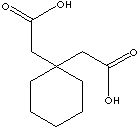| CAS NO. |
4355-11-7 |

|
| EINECS NO. |
224-427-9 |
| FORMULA |
C6H10(CH2COOH)2 |
| MOL WT. |
200.23 |
| H.S. CODE |
|
| TOXICITY |
|
| SYNONYMS |
Cyclohexanediacetic acid Cyclohexandiessigsaeure |
| á cido ciclohexanodiacetico Acide cyclohexanediacetique |
| SMILES |
|
|
CLASSIFICATION
|
|
|
PHYSICAL AND CHEMICAL PROPERTIES
|
| PHYSICAL STATE |
white crystalline powder |
| MELTING POINT |
181 - 185 C
|
| BOILING POINT |
|
| SPECIFIC GRAVITY |
|
| SOLUBILITY IN WATER |
|
| AUTOIGNITION |
|
| pH |
|
| VAPOR DENSITY |
|
| NFPA RATINGS |
Health: 2 Flammability: 0 Reactivity: 0 |
| REFRACTIVE INDEX |
|
| FLASH POINT |
|
| STABILITY |
Stable under ordinary conditions. |
|
APPLICATIONS
|
| 1,1-Cyclohexanediacetic acid, dicarboxylic acid-substituted C-6 alicyclic hydrocarbon, can exhibit typical carboxyl group chemistry in variety of industrial applications. There are almost infinite esters obtained from thousands of potential starting materials. Esters are formed by removal of water from an acid and an alcohol, e.g., carboxylic acid esters, phosphoric acid esters, and sulfonic acid esters. Carboxylic acid esters are used as in a variety of direct and indirect applications. Lower chain esters are used as flavouring base materials, plasticizers, solvent carriers and coupling agents. Higher chain compounds are used as components in metalworking fluids, surfactants, lubricants, detergents, oiling agents, emulsifiers, wetting agents textile treatments and emollients, They are also used as intermediates for the manufacture of a variety of target compounds. The almost infinite esters provide a wide range of viscosity, specific gravity, vapor pressure, boiling point, and other physical and chemical properties for the proper application selections. Other derivatives from carboxylic acid include acyl halides, anhydrides, and nitriles. They are used in preparing flavoring agents, internal plasticizers, pesticides, dyes, textile treatment agents, fungicides, and pharmaceuticals through further reactions of substitution, catalytic reduction, metal hydride reduction, diborane reduction, keto formation with organometallic reagents, electrophile bonding at oxygen, and condensation. Carboxylic acid provides covalently linked structure with hydroxy group. It can form amide derivatives. It is a metal chelator. Chelation is applied in metal complex chemistry, organic and inorganic chemistry, biochemistry, and environment protection. It is used in chemotherapeutic treatments for metal poisoning. An example of end product derived from 1,1-cyclohexanediacetic acid is gabapentin, an anti-epileptic agent, chemically described as 1-(aminomethyl)cyclohexane acetic acid. |
| SALES SPECIFICATION |
|
APPEARANCE
|
white crystalline powder |
|
ASSAY
|
98.5% min
|
| LOSS ON DRYING
|
0.5% max
|
| TRANSPORTATION |
| PACKING |
25kgs in fiber drum |
| HAZARD CLASS |
|
| UN NO. |
|
| OTHER INFORMATION |
|
Hazard Symbols: XI, Risk Phrases: 36/37/38, Safety Phrases: 24-25-28A-37-45 |
|
GENERAL DESCRIPTION OF CYCLOHEXANE |
|
Cyclohexane is the six-membered alicyclic hydrocarbon consisting of six carbon atoms linked to each other to form a ring, with each carbon atom bearing two hydrogen atoms, C6H12. A cyclic compound is an organic compound that contains one or more closed rings of carbon atoms. The term alicyclic refers to cyclic compound that behaves chemically like aliphatic compounds (open-chain), which means the exclusion of carbocyclic compounds of aromatic rings with an array of π-electrons characteristic. Cyclohexane is a colorless, highly flammable, mobile liquid with a pungent odor. It is insoluble in water and soluble in alcohol, ether, and almost organic solvents. Cyclohexane is a non-corrosive and quick volatilize liquid and sublimes between -5 to 5 C. Cyclohexane can exist in a number of interconvertible three-dimensional conformations, the two simplest being are the chair and boat conformation and others include the half-chair and twist-chair conformation. Cyclohexane can cause irritation to the eyes and mucous membranes in workers. Repeated and prolonged contact with skin may cause dermatitis. The substance has not been shown to cause the hematologic changes associated with exposure to benzene. Cyclohexane occurs naturally in crude oils. Some cyclohexane is recovered from petroleum streams by fractionation. The bulky commercial production of cyclohexane is based on hydrogenation of benzene in closed system. Cyclohexane consumption is linked almost entirely to nylon production. Nylon is further processed into fibers for applications in carpeting, automobile tire cord, clothing, and other growing industrial fields. Cyclohexane is used as a solvent, oil extractant, paint and varnish remover, dry cleaning material, and in solid fuels. It has been used as a insecticide itself. Cyclohexane is used as a chemical intermediate to produce target molecules. Natural compounds of one to five alicyclic rings with great variety and complexity are found particularly in steroids and terpenes. Cyclohexane structure, six membered-ring, is one of the major skeleton in nature. Cyclohexane derivatives can be used for the synthesis of pharmaceuticals, dyes, herbicides, plant growth regulator, plasticizers, rubber chemicals, cycloamines and other organic compounds. |
